jigging
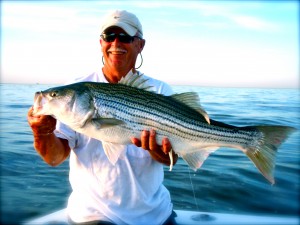 The good news is that those migratory fish I talked about last week – you know, the ones that sneak in through the C&D canal every October – well, they’re here. Since last Tuesday, reports of big, clean fish with sea lice have been flooding in. The bad news is that the Upper Chesapeake Bay is still so murky that those big stripers are moving quickly down the channel searching for cleaner water and more plentiful bait fish. They haven’t gone too far south, but they have bypassed the northern humps and ledges where we’ve found them in years past. The ugly part is that, since those fish showed up in some very accessible high-traffic areas, word got out quickly and a bite that traditionally lasts until the end of October shut down in just a few days. At the end of last week, fishing was very good, but soon hoards of inexperienced fishermen, some with screaming kids, running engines, and blaring radios, descended on an area that is shorter and narrower than a football field. That caused the fish to hunker down and become very difficult to catch. Difficult, but not impossible. It’s been a tough week, but there are trophy stripers in our area right now, and fishing is sure to improve as more and more migratory fish enter the Chesapeake.
The good news is that those migratory fish I talked about last week – you know, the ones that sneak in through the C&D canal every October – well, they’re here. Since last Tuesday, reports of big, clean fish with sea lice have been flooding in. The bad news is that the Upper Chesapeake Bay is still so murky that those big stripers are moving quickly down the channel searching for cleaner water and more plentiful bait fish. They haven’t gone too far south, but they have bypassed the northern humps and ledges where we’ve found them in years past. The ugly part is that, since those fish showed up in some very accessible high-traffic areas, word got out quickly and a bite that traditionally lasts until the end of October shut down in just a few days. At the end of last week, fishing was very good, but soon hoards of inexperienced fishermen, some with screaming kids, running engines, and blaring radios, descended on an area that is shorter and narrower than a football field. That caused the fish to hunker down and become very difficult to catch. Difficult, but not impossible. It’s been a tough week, but there are trophy stripers in our area right now, and fishing is sure to improve as more and more migratory fish enter the Chesapeake.
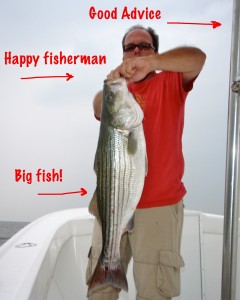 No man, after catching a big fish, goes home through an alley. – Ancient Chinese Proverb
No man, after catching a big fish, goes home through an alley. – Ancient Chinese Proverb
Maybe you’ve heard someone recite another old saying about “the three stages of a fisherman’s life.” It goes something like this: The first stage is when the angler’s main objective is to catch as many fish as possible, the second stage is when the angler only searches for the larger fish, and the third and final stage is when size doesn’t matter and the capture is unimportant, but satisfaction comes from the way the angler tricks the fish. I usually nod my head in agreement when I hear that, but c’mon now, I don’t know one single fisherman who, when given a choice, doesn’t cast toward the biggest fish in the pond. We can wax poetic about the joys of baptizing ourselves in the boundless beauty of nature, and we can sing the praises of that peaceful solitude we find out on the open water, but screw it – the bottom line is, no matter how we are fishing, we want to catch a whopper! In this third and final segment of the Gimme a Breaker series, we’re looking at ways to get the lunkers out of surface blitzing Chesapeake rockfish. Read More!
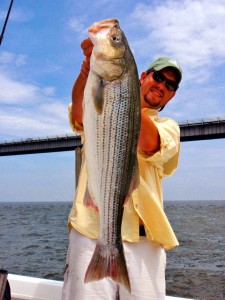 Have you heard? Light tackle casting is producing big fish lately on the Chesapeake Bay. Some lucky anglers are catching fish over 30-inches on almost every trip. Sometimes they get three or four. Most of the fish I’m catching are coming off cover like rocks or bridge pilings, but some have been hooked while fishing submerged structure in open water. Both soft plastics and metal jigs are producing. If you’ve been out, I hope you’re enjoying some lucky days. 30-inch plus stripers in late June is something to celebrate, especially considering how tough fishing has been previously.
Have you heard? Light tackle casting is producing big fish lately on the Chesapeake Bay. Some lucky anglers are catching fish over 30-inches on almost every trip. Sometimes they get three or four. Most of the fish I’m catching are coming off cover like rocks or bridge pilings, but some have been hooked while fishing submerged structure in open water. Both soft plastics and metal jigs are producing. If you’ve been out, I hope you’re enjoying some lucky days. 30-inch plus stripers in late June is something to celebrate, especially considering how tough fishing has been previously.
In my opinion, seasoned anglers make a lot of their own luck. Since the fish are more inclined to bite now, I thought it might be worthwhile to discuss tips for hooking and landing bigger fish – just some little things that can move fishermen up from the usual summer schoolies to true summer trophies. You probably have a few tips as well, so feel free to share them in the comments section. I’ll start with the basics: Read More!
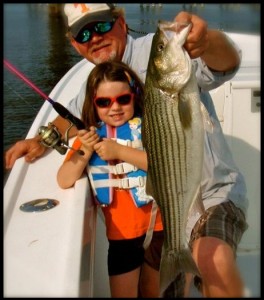 I recently found some old pictures of myself in diapers, standing beside a small wooden boat parked in front of a Tennessee farmhouse. Towering above me was my father, and at my bare feet was a nice stringer of fat largemouth bass. Did I catch them? Probably not, but like any good fisherman, I’ll happily take the credit. I might even tell you a tall tale about how – at the ripe old age of two – I tricked them into biting a lure that I hand carved from a boar’s tusk with a Bowie knife, and how they pulled harder than a Smoky Mountain mule.
I recently found some old pictures of myself in diapers, standing beside a small wooden boat parked in front of a Tennessee farmhouse. Towering above me was my father, and at my bare feet was a nice stringer of fat largemouth bass. Did I catch them? Probably not, but like any good fisherman, I’ll happily take the credit. I might even tell you a tall tale about how – at the ripe old age of two – I tricked them into biting a lure that I hand carved from a boar’s tusk with a Bowie knife, and how they pulled harder than a Smoky Mountain mule.
There’s no doubt that I owe much of what I know about fishing to my father. There’s nothing better than fishing with family. All three of my sons have become first-class fishermen. This week I’ve been fishing with my family’s next generation of anglers. I’ve had a great time on the water with my son Daniel and my granddaughter Ella. I’m happy to report that Chesapeake Bay salinity levels are finally climbing back toward normal levels (see chart below), although they’re still low. Since conditions are stablizing, striped bass fishing is getting a little more reliable. That isn’t to say some days aren’t better than others, but we’re at the point where I at least think we can count on a few fish on any given outing.
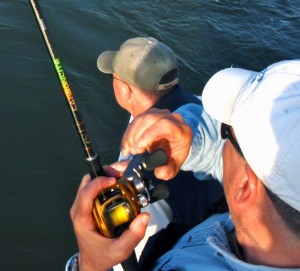 According to Wikipedia, sensitivity training is a method of behavioral modification that makes people more aware of their prejudices. Lately, I feel like I should be a little more sensitive. No, I don’t think I need to nicer to the trollers or more chivalrous to the ladies. I’m doing pretty good with those things. I’m thinking of the sensitivity I get when I have a jigging rod in my hands. When it comes to fishing, I want to be completely in-tune with my touchy-feely side.
According to Wikipedia, sensitivity training is a method of behavioral modification that makes people more aware of their prejudices. Lately, I feel like I should be a little more sensitive. No, I don’t think I need to nicer to the trollers or more chivalrous to the ladies. I’m doing pretty good with those things. I’m thinking of the sensitivity I get when I have a jigging rod in my hands. When it comes to fishing, I want to be completely in-tune with my touchy-feely side.
Due to the big crowds around the warm water discharges this spring, I’ve had plenty of opportunities to watch other light tackle fishermen in action. I’ve seen some very good anglers out there. On the other hand, I’ve noticed a few guys who have struggled. Other than disregarding the basic principles of stealth, the biggest mistake I see fishermen make is not feeling for their lures to touch the bottom when they’re jigging. Read More!
It’s been a snowy week here on Kent Island. We’re still digging out as one cold front after another sweeps across the mid-Atlantic. With more snow in the forecast, it looks we’ll be hard-pressed to get in many catch & release striper trips in the near future. 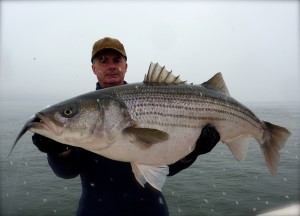 Fortunately, I was able to get out for a few hours this snowy weekend. I had planned to launch my center console Thunder Road, but my neighbor Mark called to say he was up for a trip if we wanted to go in his Parker. That was a no-brainer since he has a heated cabin. My buddy Jamie joined us. As thunder rumbled across the Chesapeake Bay, we broke through the ice at Queen Anne Marina and set off into the fog, rain, and snow. I’ll let the video tell the story with the caveat that jigging is very much a hit or miss enterprise this time of year. Just because fish are there one day doesn’t mean they will be the next. The best bet is to fish locations where the fish can find warmer water. Here’s the video report:
Fortunately, I was able to get out for a few hours this snowy weekend. I had planned to launch my center console Thunder Road, but my neighbor Mark called to say he was up for a trip if we wanted to go in his Parker. That was a no-brainer since he has a heated cabin. My buddy Jamie joined us. As thunder rumbled across the Chesapeake Bay, we broke through the ice at Queen Anne Marina and set off into the fog, rain, and snow. I’ll let the video tell the story with the caveat that jigging is very much a hit or miss enterprise this time of year. Just because fish are there one day doesn’t mean they will be the next. The best bet is to fish locations where the fish can find warmer water. Here’s the video report:


